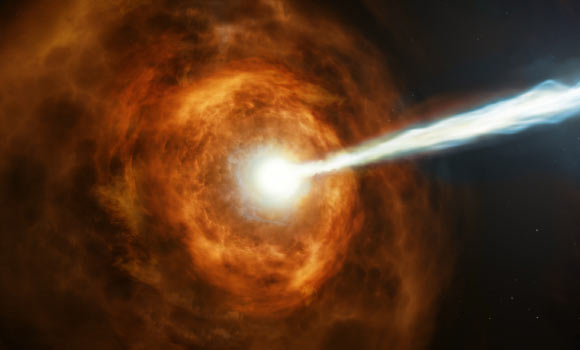Catastrophic Collapse of Giant Stars’ Magnetic Fields Powers Gamma-Ray Bursts | Astronomy – Sci-News.com
Gamma-ray bursts are the most energetic explosions in the Universe, beaming out huge jets of light-emitting plasma, which travel through space at 0.99 times the speed of light, as a giant star collapses into a spinning black hole. When a jet points towards Earth, the afterglow can be detected from ground and space-borne telescopes. Many astronomers favor an explanation for gamma-ray bursts based on the baryonic jet model, which states that repeated violent collisions between material blasted out during the explosion and material surrounding the star produce the gamma-ray flash and the subsequent fading afterglow. A second hypothesis, called the magnetic model, posits that a huge, primordial magnetic field in the star collapses within seconds of the initial explosion, releasing energy to power the blast. Now, a research team led by University of Bath astronomer Nuria Jordana-Mitjans has found evidence backing the magnetic model.

Hubble’s observations suggest that GRB 190114C displayed powerful emission because the collapsing star was sitting in a very dense environment, right in the middle of a bright galaxy 5 billion light years away. Image credit: NASA / ESA / Hubble / M. Kornmesser.
In the study, Jordana-Mitjans and colleagues examined data from the collapse of a massive star in a galaxy 5 billion light-years away.
The researchers were alerted to the star’s collapse after its gamma-ray flash, named GRB 190114C, was detected by NASA’s Neil Gehrels Swift Observatory on January 14, 2019.
They noted a startlingly low level of polarization in GRB 190114C in the moments straight after the star’s collapse, indicating the star’s magnetic field had been destroyed during the explosion.
“From previous studies, we expected to detect polarization as high as 30% during the first hundred seconds after the explosion,” Jordana-Mitjans said.
“So we were surprised to measure just 7.7% less than a minute after the burst, followed by a sudden drop to 2% soon after.”
“This tells us that the magnetic fields collapsed catastrophically straight after the explosion, releasing their energy and powering the bright light detected across the electromagnetic spectrum.”
Seconds after the Swift observatory identified GRB 190114C, robotic telescopes located in the Canary Islands and South Africa received NASA’s discovery notification and repointed.
Within one minute of the discovery, the telescopes were gathering data about the emissions.
“Our innovative telescope systems are entirely autonomous, with no humans in the loop, so they slued very quickly and began taking observations of the GRB almost immediately after its discovery by the Swift satellite,” said University of Bath’s Professor Carole Mundell.
“It is remarkable that from the comfort of our own homes, we were able to discover the importance of primordial magnetic fields in powering a cosmic explosion in a distant galaxy.”
The team’s paper was published in the Astrophysical Journal.
_____
N. Jordana-Mitjans et al. 2020. Lowly Polarized Light from a Highly Magnetized Jet of GRB 190114C. ApJ 892, 97; doi: 10.3847/1538-4357/ab7248






